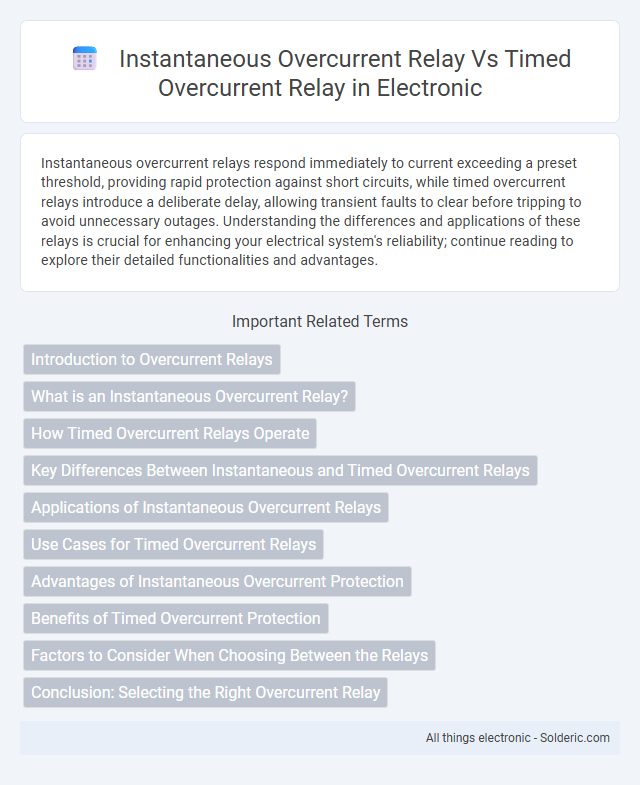Instantaneous overcurrent relays respond immediately to current exceeding a preset threshold, providing rapid protection against short circuits, while timed overcurrent relays introduce a deliberate delay, allowing transient faults to clear before tripping to avoid unnecessary outages. Understanding the differences and applications of these relays is crucial for enhancing your electrical system's reliability; continue reading to explore their detailed functionalities and advantages.
Comparison Table
| Feature | Instantaneous Overcurrent Relay | Timed Overcurrent Relay |
|---|---|---|
| Operating Principle | Trips immediately when current exceeds preset value | Trips after a time delay proportional to overcurrent magnitude |
| Time Delay | None (instantaneous) | Adjustable time delay |
| Application | Protects against short circuits and severe faults | Protects against overloads and moderate faults |
| Sensitivity | High sensitivity to sudden high current | Less sensitive, allows short-term current surges |
| Coordination | Difficult to coordinate alone due to immediate tripping | Easy to coordinate with other protective devices using time delay |
| Typical Settings | Pickup current slightly above maximum load current | Pickup current set above normal load with time defined by protection scheme |
| Use in Protection Scheme | Backup protection for fast fault clearing | Primary protection to prevent nuisance tripping |
Introduction to Overcurrent Relays
Overcurrent relays protect electrical circuits by detecting excessive current flow that may cause damage or faults. Instantaneous overcurrent relays operate without intentional time delay, tripping the circuit immediately when current exceeds a preset threshold, ensuring rapid fault isolation. Timed overcurrent relays incorporate a time delay proportional to current magnitude, allowing coordination with other protection devices and preventing unnecessary outages caused by transient currents.
What is an Instantaneous Overcurrent Relay?
An Instantaneous Overcurrent Relay operates without intentional time delay, triggering immediately when the current exceeds a preset threshold, protecting electrical systems from sudden, severe faults. Your system benefits from its fast response, minimizing damage during short circuits or abnormal current surges. Unlike timed overcurrent relays that allow for adjustable delay to coordinate with downstream devices, instantaneous relays are crucial for rapid fault detection in critical protection schemes.
How Timed Overcurrent Relays Operate
Timed overcurrent relays operate by measuring the duration and magnitude of the electrical current exceeding a preset threshold, initiating a trip signal only after the current surpasses the threshold for a specific time delay. This time-delay feature allows coordination with other protection devices, minimizing unnecessary interruptions and ensuring selective fault isolation in your electrical system. By adjusting the time settings, these relays provide precise protection against overloads and faults while maintaining system stability.
Key Differences Between Instantaneous and Timed Overcurrent Relays
Instantaneous overcurrent relays operate without any intentional time delay when the current exceeds a preset value, providing rapid fault isolation to protect electrical systems from severe damage. Timed overcurrent relays include an adjustable time delay feature that allows temporary overcurrent conditions, such as motor startup currents, to pass without tripping, improving selectivity and coordination in protection schemes. The key differences lie in response time and application: instantaneous relays respond immediately to faults, while timed relays balance sensitivity and time delay for system coordination and reliability.
Applications of Instantaneous Overcurrent Relays
Instantaneous overcurrent relays are widely used in power systems for rapid fault detection and protection against short circuits, especially in transmission lines and industrial electrical networks where immediate response is critical. Their ability to trip without intentional time delay makes them ideal for safeguarding cables, transformers, and generators from severe damage due to sudden current surges. You can rely on these relays to minimize equipment stress and maintain system stability by quickly isolating faulted sections.
Use Cases for Timed Overcurrent Relays
Timed overcurrent relays are primarily used in distribution systems where selective coordination and graded protection are essential to isolate faults without disrupting the entire network. They provide adjustable time delays, allowing downstream relays to clear faults first, minimizing service interruptions and equipment damage. These relays are ideal for protecting feeders, transformers, and motors where fault clearance timing can prevent unnecessary outages.
Advantages of Instantaneous Overcurrent Protection
Instantaneous overcurrent protection offers rapid fault detection and clearance, minimizing equipment damage and enhancing system stability by responding without intentional delay. This relay type excels in safeguarding critical components during severe short circuits by instantly isolating faults, reducing outage duration and improving overall reliability. The simplicity and quick action of instantaneous overcurrent relays make them ideal for zones requiring fast fault clearance in high-risk or high-value installations.
Benefits of Timed Overcurrent Protection
Timed overcurrent relays provide selective coordination by allowing time delays that prevent nuisance tripping during transient faults, improving the overall stability of power systems. They enable more precise fault discrimination, which helps protect downstream equipment without interrupting the entire network. The adjustable time settings enhance system reliability and optimize protection schemes by aligning relay operation with specific fault conditions.
Factors to Consider When Choosing Between the Relays
When selecting between instantaneous overcurrent relays and timed overcurrent relays, consider the system's fault current magnitude, as instantaneous relays respond within milliseconds to high fault currents, providing fast protection but risking nuisance tripping. Timed overcurrent relays offer adjustable delay settings to coordinate with downstream devices, ensuring selective isolation and minimizing service interruptions. Your choice depends on the desired balance between speed of fault detection and coordination with other protective devices in the network.
Conclusion: Selecting the Right Overcurrent Relay
Instantaneous overcurrent relays respond immediately to current surges, providing fast protection against severe faults, while timed overcurrent relays incorporate intentional delays to coordinate with other protective devices and minimize unnecessary trips. Your choice depends on system complexity, fault characteristics, and coordination requirements to ensure reliable and selective protection. Selecting the right overcurrent relay balances speed and coordination for optimal system safety and performance.
instantaneous overcurrent relay vs timed overcurrent relay Infographic

 solderic.com
solderic.com